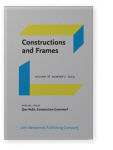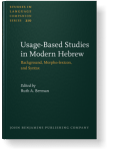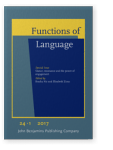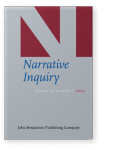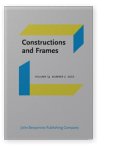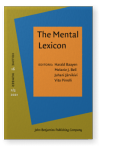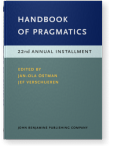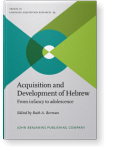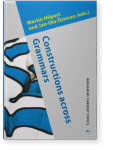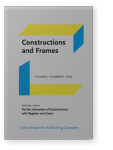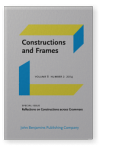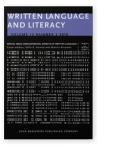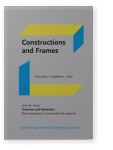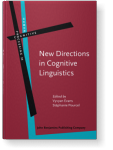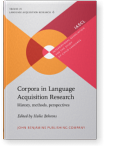Bracha Nir
List of John Benjamins publications for which Bracha Nir plays a role.
Journal
Titles
Usage-Based Studies in Modern Hebrew: Background, Morpho-lexicon, and Syntax
Edited by Ruth A. Berman
[Studies in Language Companion Series, 210] 2020. xviii, 682 pp.
Subjects Afro-Asiatic languages | Theoretical linguistics
Stance, resonance and the power of engagement
Edited by Bracha Nir and Elisabeth Zima
Special issue of Functions of Language 24:1 (2017) v, 137 pp.
Subjects Corpus linguistics | Discourse studies | Functional linguistics | Pragmatics | Theoretical linguistics
2024 Emotional engagement in expressive writing: Clinical and discursive perspectives Narrative Inquiry 34:1, pp. 191–223 | Article
HaCohen et al. (2018) identified three types of narratives that emerge in the context of integrating a difficult event into one’s life story. We use their identification while focusing on the quality of emotional involvement evidenced in texts, and combining it with an abstract-content text… read more
2023 Variation of sign parameters in narrative and expository discourse: A view from Israeli Sign Language Sign Language & Linguistics 26:2, pp. 218–257 | Article
The paper presents an in-depth study of variation in sign parameters of Israeli Sign Language (ISL). We describe and analyze specific sign parameters and their sub-parameters: handshape, orientation, place of articulation, and movement, as they are distributed in two text-types: narrative and… read more
2022 Editorial announcement Constructions and Frames 14:2, p. | Editorial
2021 Learning beyond words: Morphology and the encoding of hierarchical categories The Mental Lexicon 16:2/3, pp. 397–421 | Article
Learning multimorphemic words involves the simultaneous learning of two hierarchically organized categories. In such words, sub-lexical units usually encode superordinate categories, whereas whole words encode exemplars of these categories. Complex, non-linear word structure is common in Semitic… read more
2020 Chapter 18. A usage-based typology of Modern Hebrew syntax: How Semitic? Usage-Based Studies in Modern Hebrew: Background, Morpho-lexicon, and Syntax, Berman, Ruth A. (ed.), pp. 659–676 | Chapter
The chapter considers how findings from Modern Hebrew syntax shed light on the
usage-based domain of contemporary linguistic typology, defined as concerned with the
synchronic and diachronic interrelations between function and grammar. To do so, it provides
illustrations from well-discussed… read more
2019 Event representation Handbook of Pragmatics: 22nd Annual Installment, Östman, Jan-Ola and Jef Verschueren (eds.), pp. 79–92 | Chapter
2017 Resonance as a resource for stance-taking in narratives Stance, resonance and the power of engagement, Nir, Bracha and Elisabeth Zima (eds.), pp. 94–120 | Article
This paper traces the recurrence and manipulation of devices in monologic narrative texts produced by university students based on a semi-structured elicitation. It focuses on a detailed analysis of multiple texts produced by different speaker-writers of Hebrew, to illustrate the function of… read more
2017 The power of engagement: Stance-taking, dialogic resonance and the construction of intersubjectivity Stance, resonance and the power of engagement, Nir, Bracha and Elisabeth Zima (eds.), pp. 3–15 | Article
2016 Development of intra- and inter-clausal dependency in Hebrew Acquisition and Development of Hebrew: From infancy to adolescence, Berman, Ruth A. (ed.), pp. 259–294 | Article
The chapter relies on the notion of dependency marking as a framework for a reinterpretation of data on syntactic development in Hebrew from early childhood to adulthood. Following a short outline of how grammatical dependencies are realized in Hebrew, I explore the emergence of dependencies in… read more
2016 Clause combining across grammars: A contrastive analysis of L1 and L2 construal of discourse organization Constructions across Grammars, Hilpert, Martin and Jan-Ola Östman (eds.), pp. 97–130 | Article
The goal of the present study is to examine whether clause-combining rhetorical preferences that differentiate between Hebrew and English are maintained across grammars, specifically, in the context of text production in a non-native language. It examines the usage of various bi-clausal… read more
2015 Frames for clause combining: Schematicity and formulaicity in discourse patterns On the Interaction of Constructions with Register and Genre, Fischer, Kerstin and Kiki Nikiforidou (eds.), pp. 348–379 | Article
The present study joins recent endeavors within Construction Grammar to recognize constructions that are beyond clauses and sentences and function as schematic frames for the organization of discourse. Specifically, it deals with two particular instances of what is termed a discourse pattern, the… read more
2014 Clause combining across grammars: A contrastive analysis of L1 and L2 construal of discourse organization Reflections on Constructions across Grammars, Hilpert, Martin and Jan-Ola Östman (eds.), pp. 232–265 | Article
The goal of the present study is to examine whether clause-combining rhetorical preferences that differentiate between Hebrew and English are maintained across grammars, specifically, in the context of text production in a non-native language. It examines the usage of various bi-clausal… read more
2014 Development of adjective frequencies across semantic classes: A growth curve analysis of child speech and child-directed speech Language, Interaction and Acquisition 5:2, pp. 185–226 | Article
This paper is a longitudinal investigation of adjective use by children aged 1;8−2;8, speaking Dutch, German, French, Hebrew, and Turkish, and by their caregivers. Each adjective token in transcripts of spontaneous speech was coded for semantic class. The development of adjective use in each… read more
2010 The lexicon in writing–speech-differentiation Developmental aspects of written language, Vernon Carter, Sofía A. and Mónica Alvarado (eds.), pp. 183–205 | Article
The study analyzed text-embedded lexical usage as diagnostic of writing-speech-distinctions in stories and discussions produced in the two modalities by English-speaking grade-school children, middle-school pre-adolescents, high-school adolescents, and adults. We assumed that (1) while children… read more
2010 Parts of speech as constructions: The case of Hebrew “adverbs” Grammar and interaction: New directions in constructional research, pp. 242–274 | Article
The paper re-appraises accepted classifications of linguistic elements into word-level constructions on the one hand and in terms of Parts-of-Speech systems on the other from the point of view of Construction Grammar (CxG). We focus on a particular adverbial construction in Hebrew, with the… read more
2009 Cognitive and linguistic factors in evaluating text quality: Global versus local? New Directions in Cognitive Linguistics, Evans, Vyvyan and Stéphanie Pourcel (eds.), pp. 421–440 | Article
2008 Core morphology in child directed speech: Crosslinguistic corpus analyses of noun plurals Corpora in Language Acquisition Research: History, methods, perspectives, Behrens, Heike (ed.), pp. 25–60 | Article
